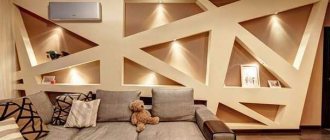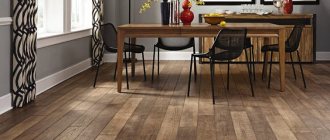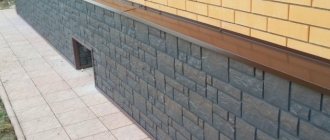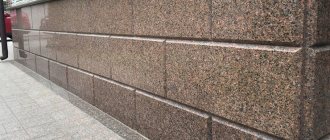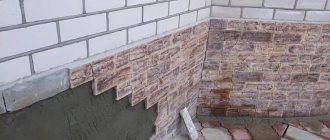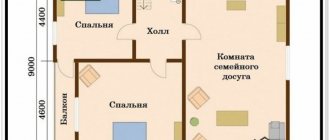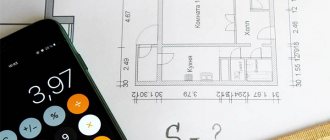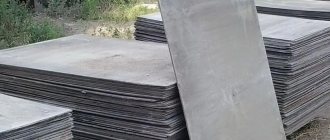The cost of real estate, when purchasing it, is calculated taking into account the total area of the house. Consequently, every square meter can be subject to manipulation by the seller or developer.
The basis for determining the footage of a building is the cadastral passport, which indicates all the characteristics of the building. Practice shows that the most controversial issues when determining the area of country houses are the premises of the ground floor or basement, which sellers can arrange as a full floor or leave “in the shade”.
For example, the owner decided to build a house on 3 floors in an area where it is only allowed to build buildings on 2 levels. A basement of the right height will allow him to realize his idea legally. On the contrary, if you build a building not according to the regulations, then it will not be able to be put into operation.
Information regarding calculations of the number of storeys can be useful not only to buyers of ready-made cottages, but also to those who are planning to build a house. We will talk about all the definitions of the number of storeys in a house in this article.
Ceiling height standards in private houses
If we want to determine what the correct parameters of private houses and cottages should be, it is worth paying attention to the content of SNiP standards. These building codes and parameters are written by the state and their primary task is to create comfortable and safe living conditions for people in residential premises.
Clause 4.5 02/31/2005 establishes restrictions on the minimum height of premises in a private house from floor to ceiling:
- the bedroom, living rooms and kitchen must have a room height of at least 2.7 m;
- other rooms - at least 2.5 m;
- for the top floor and attic this limit is 2.3 m.
Features of Burj Khalifa
When implementing such a non-standard project, non-standard solutions are required. As a result, a special grade of concrete was even developed for the building. It can withstand temperatures up to +50 degrees Celsius. To make the structure stronger, the concrete mixture was laid only at night, and ice was added to the solution. Of course, the spider is far from such technologies.
The complexity of the foundation lies in the fact that the tower essentially stands on loose soil. Unlike many skyscrapers, which are built on a rocky foundation, the Burj Khalifa is built on soft ground. To prevent the structure from falling apart or tilting, the foundation was placed on piles 45 meters long and 1.5 meters thick. There are about 200 such piles in the structure.
Burj Khalifa looks very beautiful now. Especially when there is a park around it and not a construction site.
To ensure that the building is not exposed to strong winds in the desert, it has an aerodynamic cross-sectional shape. This way the wind flows better around the structure. At the same time, swaying is still inevitable, but so that it is not so large, the shape of the tower is made asymmetrical.
The glazing of the Burj Khalifa consists of special tinted thermal panels. Considering that in Dubai the temperature during the day reaches +50 degrees Celsius, such a solution is simply necessary. This requires significantly less load on the air conditioning system. Moreover, the glazing area is approximately 17 times larger than the area of a football field. It takes approximately 3 months to wash such an area. Due to sandstorms, the building gets dirty faster. Therefore, it is washed almost constantly.
The cost of apartments in Burj Khalifa varies greatly, but starts from half a million euros.
The building houses the Armani Hotel, located from the 1st to the 39th floor. The design was developed personally by Giorgio Armani. From the 44th to the 108th floor (but not on all floors) there are 900 apartments, and the 100th floor was completely purchased by the Indian billionaire B.R. Shetty. There are three of his apartments on this floor. Offices are located from the 111th to 154th floors, and the world's highest observation deck (555 meters) is on the 148th floor.
This is what the Armani Hotel looks like in the tallest building in the world.
This is the price of a double room for two days at the Armani Hotel in Dubai. However, there are no places available for the next few months.
At the entrance to the building there is an artificial lake with an area of 12 hectares with a musical fountain. Almost 7,000 light sources are used to illuminate it. It only remains to add that the height of the fountain’s jets reaches 150 meters. That's a hell of a lot!
An interesting feature of the building is the water collection system. This is a kind of gold standard for the environmental friendliness of modern buildings, when rainwater is collected and used for technical needs. In Dubai, there is critically little rainfall throughout the year, and there is no need to talk about such a system, but it does exist. True, it collects condensation. It is formed when a building, cooled from the inside, comes into contact with hot air from the outside.
More than 40 million liters of water are collected in this way per year. Considering the water shortage in the region, this is very, very high. Water is collected from reservoirs in the building's basement and used to irrigate lawns and plants in the park around the tower.
Minimum height of plinth and basement
Firstly, if you are planning to purchase or build a house with a lower floor, it is important to make sure that the correct microclimate is created inside the basement and basement rooms, otherwise the walls will become damp and the stability of the house will decrease over the years.
Secondly, in accordance with paragraph 1.41 of document 2.08.01-89, there is a definition of standards for the height of the ground floor and basement. The height of their ceilings must be at least 1.8 m.
If the basement floor is used as a garage or parking for vehicles, it is important that the distance from the ceiling to the ceiling is at least 2 meters. For the room where the boiler room will be located, the minimum height threshold is 2.2 m.
Typical buildings of the USSR
Typical panel and brick 5-story houses began to be actively built during the times of Khrushchev, starting in 1957. The country needed cheap housing and as quickly as possible. That is why such projects were developed, some intended for the southern regions, others for the northern. The brick ones had a slightly better layout and room sizes.
The same serial project, built in different regions, could be slightly different. Different climatic conditions and the soils on which the construction was carried out made their own adjustments to the size of the five-story buildings. It is clear that each project differed in the height of the building.
The length of a 5-story building with 4 entrances for a typical 5-story building of project 1-528-3k is 72.4 meters. It depended on the layout of the apartments and slightly on the thickness of the panels. The wall thickness of the panels ranges from 300 mm to 400 mm.
The length of the five-story building with 4 entrances is 72.4 meters
“Brezhnevki” were built until the end of 1980, and successful projects are being taken as a basis even now. They were not particularly different from the “Khrushchev” apartments, but the entrance area was larger, the flights of stairs were wider and a garbage chute was installed.
What are they guided by when determining the number of storeys of houses?
From a visual point of view, the number of floors is usually calculated based on the number of windows above the ground. Technically, it is believed that a full floor is a level whose ceiling is located above the ground.
In order for the basement to be included in the living area of the house, its ceiling must be located above ground level. If the ceiling (floor) is located below, then such premises are already included in the living area, but may or may not be included in the common area.
Let's look at these concepts in more detail.
When drawing up documentation, specialists indicate its number of floors in the object’s passport. In addition to this indicator, the number of underground premises is also indicated, which are divided into:
- socle (ground floor);
- basement;
- boiler room;
- cellar;
- technical rooms, etc.
Example: in the column “Number of floors” the number 3 is indicated, in the column “Underground floors” they are written 1, and the number of storeys of the house is the difference between these two indicators. Therefore, the house is considered to be two-story.
Two and three-story houses: benefits and disadvantages
Among the disadvantages of two-level houses, experts note:
- The walls of a house of more than one floor need to be laid with at least one and a half bricks
. This makes construction more expensive and robs completion time. - A two- and three-story house requires good soundproofing
between levels. This will require a reinforced concrete monolithic slab of the same area as the foundation. But the cost of performing work with this type of floor is much higher than simply making a foundation.
A modern three-story house with a large glass area needs good sound insulation, which increases the cost of work and technological features. Source pinterest.com
Can the basement be considered the fourth floor?
According to Article 48 of the Civil Code of the Russian Federation, restrictions are provided for private, individual buildings. And it clearly states that the height of cottages in Russia cannot exceed 3 floors.
Otherwise, this is no longer an individual housing construction project (individual housing construction). And completely different requirements apply to it (as to residential complexes). If you built/bought such a house on private housing construction land, you will not be able to legalize it, and most likely you will have to demolish a floor or even the entire building.
Important: By law, the maximum height of single-family cottages is limited to 3 floors.
Are the basement and basement considered floors?
Yes, if their ceilings and floors protrude 2 meters or more above the ground.
Are the basement and basement counted in the total number of storeys of the house?
Yes.
The terms “number of storeys” and “number of floors” are enshrined in Article 49 of the Town Planning Code of the Russian Federation. According to it, the number of floors is considered to be the totality of all types of premises - technical, underground, basement, basement, above-ground and attic.
About 10-15 years ago, some developers, taking advantage of the inexperience of buyers, “cunned” and built their properties, violating these norms, offering, under the guise of 3-story houses, actually 4-story buildings. However, over time, buyers became more educated and stopped buying them, so most of these construction sites remained vacant lots and “unfinished”, which can often be observed in the suburbs of any large Russian city.
Video description
To see the choice between a one- and two-story house, watch the video:
A staircase in a house with two or more floors is a separate big problem:
if it is well made and gently sloping, it can “pull” up to 20% of the total cost of construction of one floor; not everyone is comfortable using it - small children and elderly people often fall from them due to carelessness and get injured; the presence of a flight of stairs steals space on both the first and second floors, and the room where it is located automatically turns into an additional hall - the usable area becomes less and less.
Multi-level residential buildings also have useful aspects. Such houses can easily fit into 1/6 of a small plot of land of 6 acres; there will still be room for landscaping and some local areas.
Two-story houses are well suited for large families with children - everyone has their own room. Many people, even at the planning stage, include a balcony leading from the attic or second floor into the project. This decision will seem correct to the owners even 10 years after moving in, if the place where it is located offers a beautiful view.
The facade of a two-story house with an attic floor is an excellent solution for rational use of space. Source moydom.net.ua
What other requirements apply to houses under individual housing construction?
In the Town Planning Code, the definition of the concept of an individual housing construction object (IHC) includes buildings with residential and auxiliary premises that are necessary for the full functioning and life of a person in the house (clause 3, article 48).
If the cottage meets the above parameters and has no more than 3 floors, then you will not have to create design documentation for it, even if you decide to renovate, reconstruct or overhaul it.
How to obtain permission for individual housing construction? What does a developer need to know?
Limiting authorities follow the development procedure and approve documents for individual housing construction according to RSN 70-88. Thanks to them, not only the accuracy of site development is determined, but also the layout of the home and auxiliary buildings. This project needs to be carefully considered, because what is not shown in the plan will be recognized as an unauthorized structure and must be demolished or re-approved.
Without permission, that is, before the plan is approved and documents are received, work should not begin, otherwise serious problems may arise. In order to find out exactly what documents will be required to start construction, you should read the “Code of Rules for Design and Construction SP 11-III-99”.
In 2010, SNiPs were recognized as sets of mandatory rules. They regulate activities in the field of urban planning, as well as engineering work, design and construction.
In order to obtain permission, you need to contact the BTI or the city architectural department to provide:
- application for planning permission;
- documents establishing the right to use the site;
- certificate of field determination of boundaries, placement of buildings, etc.;
- cadastral plan of the site;
- House project.
Once issued, the permit is valid for 10 years.
Why does the number of floors in a house play an important role?
Firstly, as we described earlier, some unscrupulous sellers and developers may wishful thinking - that is, when specifying the living space in the contract, include basements, low plinths, technical premises, etc.
Secondly, depending on the total area of the building, the owner may pay less property tax. Therefore, if you do not plan to use technical floors, it is worth building them in accordance with the technical parameters. Then they will not be included in the total area of the house.
How are the basement and basement taken into account in the BTI?
On the Internet and on forums, owners of country cottages often write that when examining their basement floors by experts from the technical inventory bureau, the following are first taken into account:
- ceiling height;
- presence of windows in the rooms.
This means that the lower floor, protruding high above ground level, may well be considered by BTI specialists to be full-fledged, even if you do not plan to use it in the future.
A large number of different interpretations and discrepancies in different authorities does not allow us to put an end to this issue. We recommend taking into account SNiP standards when planning the construction of a residential building, and if there are doubts or unusual situations, request appropriate clarification from the local administration.
Did you find this article helpful? Please share it on social networks: Don't forget to bookmark the Nedvio website. We talk about construction, renovation, and country real estate in an interesting, useful and understandable way.
Briefly about the main thing
The standard ceiling height is determined by many reasons: the area of the house and premises, the region of construction, the purpose of the rooms, and an understanding of comfort. However, in different eras its meaning fluctuated in different directions under the influence of external circumstances.
In addition to the standard, balanced ones, there are high and low varieties of height, each with its own advantages and disadvantages. As a rule, the final solution is chosen for reasons of prestige or economy. You can bring the ceiling height closer to the standard one by visual means, using a play of color and pattern. Suspended and tensile structures and various decor (beams, stucco) will help make the room lower.
Ratings 0
Balcony layout
A balcony is a familiar element of city apartments, a place where you can plant a garden or even a vegetable garden, or just relax while admiring the view. In a country house there is no such need, because terraces or verandas on the site can cope with all this quite successfully.
But some owners of private houses still organize a balcony on the second floor. In this case, you need to take into account that the balcony is not too large, otherwise it may cover the windows of the first floor premises with its shadow. Some suburban layouts involve placing a terrace on the first floor and a balcony on the second in one vertical direction.
Anna Radjabova:
— Ultimately, everything depends on the wishes of the customer. But it is worth considering that a balcony makes the project more expensive, is not easy to operate, and is used for a short period (in fact, from May to mid-September). Separately, it is worth noting the shading of the first floor, which cannot be avoided when placing a large balcony.
Window layout
The rule in this matter is: more is better than less. According to standards, a living space must have at least one window, but if the room is elongated, one will not be enough. If the house is being built according to an individual project, you can afford panoramic windows, including corner ones.
When planning window glazing you should consider:
Anna Radjabova:
— The glazing area should not be too large to avoid overheating and heat loss. It is better to choose models with a low heat transfer coefficient - or install blinds.
It is optimal if the windows in the bedrooms face east. This will provide natural lighting to the rooms and will not interfere with evening relaxation.
A large window area adds curb appeal to a home and makes rooms brighter. But heat loss in this case can be significant. To avoid this, you should choose modern double-glazed windows, and also ensure that such windows face the south and southwest.
What to consider when planning rooms
Firstly, these are sanitary and hygienic standards [1] - they determine, in particular, the provision of air in the premises. According to standards, the air in the room should be at least 25 cubic meters. m per person. You can use online calculators to calculate.
Secondly, urban planning standards[2] - what number of storeys is allowed on the territory, are there other residential buildings nearby and what should be the distance from them.
Thirdly, it is necessary to take into account the location of the building relative to other houses in order to avoid a “window to window” situation.
In addition, the design takes into account the season of residence, the number of people who will constantly be in the house, and their special requirements: for elderly relatives or small children, it is better to think about living quarters on the ground floor.
And finally, you need to take into account the orientation of the house to the cardinal points. This will help determine in which part of the building to place bedrooms, living rooms and children's rooms.
Anna Radjabova, director of luxury real estate management (participant of the CBRE partner network):
— The layout depends on the requirements and selection criteria of a particular person. This is, for example, the frequency of use (permanent, weekends, seasonal) and the number of residents. You should also take into account the parameters of the land plot and existing urban planning restrictions (height and building density, red lines).
Standard options for country houses can be used if there is not much time for construction and the site is standard. If the territory has special features (for example, specific soils or elevation changes), an individual project will be needed.
The number of floors is determined by the owner, based on the wishes, budget and building standards. Most often, in our experience, clients choose two-story houses.

